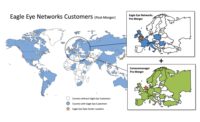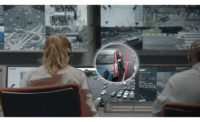Eye in the Sky
Movable cameras require rolling in a portable solution that can see, hear, speak, detect and deter — and rolling it out without a trace when its job is complete.

Mobile security units are designed to be rolled onto a site and provide a heightened level of security for an event or temporary project.
IMAGE COURTESY OF S.E.A.L. SECURITY SOLUTIONS

A mobile security unit can be placed near a business or apartment complex as an effective method of deterring crime or illegal dumping.
IMAGE COURTESY OF S.E.A.L. SECURITY SOLUTIONS

S.E.A.L. Lighting units are part of its three-pronged approach of lighting, audio and video surveillance, in addition to sensors and boots on the ground.
IMAGE COURTESY OF S.E.A.L. SECURITY SOLUTIONS


Parking lots experiencing theft and vandalism can be quickly secured using mobile unit.
IMAGE COURTESY OF S.E.A.L. SECURITY SOLUTIONS





Movable cameras, or mobile security units, fill the needs of several types of situations. Temporary work areas such as construction sites require a surveillance solution to protect people and assets during work hours and after. Sites where illegal dumping often occurs require an interactive, temporary solution to deter would-be dumpers. Events such as concerts, rallies, speeches, athletic games and fireworks are also scenarios that need a capable and adaptable temporary solution. Tower and movable cameras fill these needs in a way that traditional cameras cannot, offering multiple solutions across a range of punishing environments.
Many of these temporary situations, whether one-day events or three-year construction sites, require outdoor cameras and solutions that are resilient, says Rhedonda Cox, executive director of S.E.A.L. Security Solutions, Houston. An integrator, S.E.A.L. offers both armed officer response and technology-driven camera solutions, designing and contracting custom pieces along with buying “off-the-shelf” technology.
“In Texas where you can have extreme heat — up to 110 deg. F. — the computers for the cameras reside in a box that can get up to 200+ deg. F., so the cameras have to be able to withstand that type of heat, and also movement. These camera units are being towed over here, dragged over there, so they have to be constructed to take that kind of movement as well.”
The movable solution Cox is referring to works like a trailer for a car or truck. It attaches to a trailer hitch and looks almost like a coffin on wheels, she says. The entire apparatus is contained in this portable solution: all the batteries, the camera and a telescoping mast that can be raised and lowered depending on the user’s needs. Those used by S.E.A.L. sit at 12 feet and can go as high as 25 feet. The camera sits at the top, and the wires go down through the middle of the mast and communicate with the NVR and modem housed in the base.
The most economical method of recording video is on the NVR in the trailer; but by using Wi-Fi when available or cellular service, the solution can send video to the cloud. Companies can then pull video from their command centers when needed. Cox explains they can send customers video clips daily, in some cases. “For example, a construction site might want to have a video history of their project, so we send them a video clip each morning.” Another option is to give the customer access to the video online and allow them to pull video when they want.
Frank Jacovino, director of product development at IPVideo Corp., Bay Shore, N.Y., cautions about bandwidth and other communication issues. “If it has its own private hardwired network or its own Wi-Fi connectivity, that’s one thing; but when you get into large crowds, you have a lot of cellphone technology being used. It is hard to get connectivity. If those airwaves are flooded, it could be a really bad solution if you haven’t picked a technology that’s using a bandwidth or wavelength that isn’t commonly used.”
The video surveillance, however, is not all the solution provides — nor is it necessarily the most effective aspect of the solution. Companies can add components in addition to the cameras, routers and modem to communicate with command centers, including thermal sensors, audio and floodlights. With the three-pronged approach of lighting, audio and video surveillance, in addition to sensors, and armed officers on call, mobile units can be potent, portable and effective deterrents to crime.
One practical application is at an urban retailer Cox says has been hit multiple times by thieves. The retailer is considering a permanent solution, so S.E.A.L. Security suggested beginning with a mobile unit. “We put it right outside so everybody knows who we are, and we are giving their associates behind the counter a ‘help’ button,” Cox says. “We don’t like to call it a panic button — we call it a help button. If there is somebody of concern inside, they push the button; that alerts us to start looking at the site and zoom in to the store, and also send an officer there to give some help.”
Illegal dumping is another issue neatly discouraged by movable camera units. When people bring their mattresses and trash to dump on a site, sensors can alert central command centers and allow the security services to audibly warn the would-be perpetrator to take his trash and leave because officers have been dispatched. Jacovino says construction sites and illegal dumping are the two primary applications his company sees for movable camera units.
Many apartment complexes take advantage of the temporary nature of these solutions to alleviate certain problems such as suspected drug dealing and prostitution. “We have an eye on them, and we watch everything coming in and out,” Cox says. “That usually moves that problem out of that complex and into someone else’s — so we keep moving the cameras around.”
Failing technology is one of the biggest challenges in many of the sites where mobile units are ideal. “We had typhoon-like weather here a couple weeks ago,” Cox says. “That can be very challenging, especially if you have a solar unit. In that case, we’d have boots on the ground. We’d say, ‘OK, if we don’t have available power, then we’re going to have an officer stand post until we have enough sunlight to regenerate the battery for these cameras. So we have options other camera companies or technology companies don’t.” Cox adds that S.E.A.L. puts cameras only in places where they have armed patrols nearby.
Available power is an important factor when considering these solutions. Cox says roughly half the sites S.E.A.L. protects have no available power. In these scenarios, mobile units can be powered by batteries charged by solar or fuel cells. Even on sites where electricity is available, battery/solar backup is necessary as a backup in case someone cuts the cord or unplugs the unit — or in the case of power failure. Jacovino says battery charged by solar is the most popular option.
Not all sites are ideal for these solutions, such as communities that require a permanent, customized solution designed to blend in with the aesthetics of the landscaping and buildings. But in many situations, movable cameras fit the need perfectly. “Construction sites couldn’t care less what it looks like — in fact they want it to be seen,” Cox says. “People see the units rolling in, and they think, ‘Oh, here, we have security,’ and they can appreciate that.”
For more exclusive commentary about the benefits of deterring criminal activity using mobile units, visit The Best Defense Is a Proactive Solution at www.SDMmag.com/best-defense-proactive-solution.
|
When the Expense of Doing Nothing Is Too High When electric power may not be available and Internet connectivity is nonexistent, the options to effectively implement surveillance capabilities become scarce. In such instances, a battery powered camera with the ability to transmit over 4G/LTE and/or Wi-Fi is a viable solution. IPVideo has designed a solution for just such scenarios. “There are so many situations when the ability to quickly install secure, high-quality temporary surveillance could result in increased safety and reduced theft,” explains Jack Plunkett, chief technology officer of IPVideo Corporation. NomadHD is designed for these instances. For instance, a security director for an overnight delivery company who notices an increase in shortages on particular routes might employ a NomadHD to obtain video surveillance from within specific trucks — something not typically possible without power or Ethernet access. A NomadHD camera system provides 1080P Video transmitted over 4G/LTE and Wi-Fi networks for a minimum of eight hours on a single battery charge, in a housing case that can be easily mounted virtually anywhere. The option to power the unit via an external battery or solar charger can extend its use for longer periods of time. Its vandal and water resistant casing allows it to be put in locations where it’s needed most. “Instead of having to have a local NVR, you can go over 4G and send to a central NVR,” says Frank Jacovino, director of product development, IPVideo Corp. “It is built for very temporary, quick uses where time is of the essence, and you have no ability to supply power or network ability quickly, and the expense of not doing anything is too high.” |
Looking for a reprint of this article?
From high-res PDFs to custom plaques, order your copy today!














